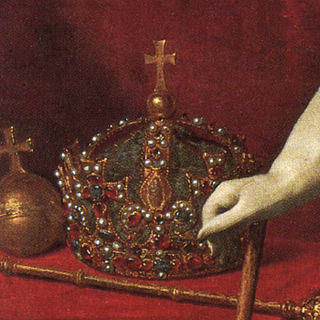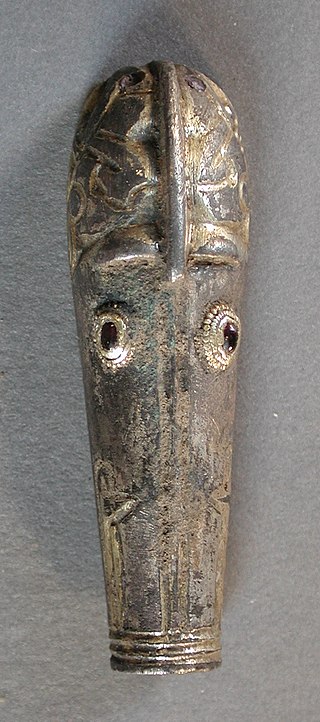This is a list of List of National Treasures of India, as named by the Antiquities and Art Treasures Act (1972). [1] [2]
This is a list of List of National Treasures of India, as named by the Antiquities and Art Treasures Act (1972). [1] [2]
| Name | Image | Notes |
|---|---|---|
| Nandalal Bose | ||
| Nicholas Roerich |  | [3] |
| Amrita Sher-Gil |  | |
| Sailoz Mookherjea | ||
| Jamini Roy | [4] | |
| Abanindranath Tagore | ||
| Gaganendranath Tagore |  | |
| Rabindranath Tagore |  | |
| Raja Ravi Varma |  |

The British Museum is a public museum dedicated to human history, art and culture located in the Bloomsbury area of London. Its permanent collection of eight million works is the largest in the world. It documents the story of human culture from its beginnings to the present. The British Museum was the first public national museum to cover all fields of knowledge.

Looting is the act of stealing, or the taking of goods by force, typically in the midst of a military, political, or other social crisis, such as war, natural disasters, or rioting. The proceeds of all these activities can be described as booty, loot, plunder, spoils, or pillage.

A treasure trove is an amount of money or coin, gold, silver, plate, or bullion found hidden underground or in places such as cellars or attics, where the treasure seems old enough for it to be presumed that the true owner is dead and the heirs undiscoverable. An archaeological find of treasure trove is known as a hoard. The legal definition of what constitutes treasure trove and its treatment under law vary considerably from country to country, and from era to era.

The Archaeological Survey of India (ASI) is an Indian government agency that is responsible for archaeological research and the conservation and preservation of cultural historical monuments in the country. It was founded in 1861 by Alexander Cunningham during the British Raj who also became its first Director-General.

Repatriation is the return of the cultural property, often referring to ancient or looted art, to their country of origin or former owners.

Treasure hunting is the physical search for treasure. For example, treasure hunters try to find sunken shipwrecks and retrieve artifacts with market value. This industry is generally fueled by the market for antiquities.

Looted art has been a consequence of looting during war, natural disaster and riot for centuries. Looting of art, archaeology and other cultural property may be an opportunistic criminal act or may be a more organized case of unlawful or unethical pillage by the victor of a conflict. The term "looted art" reflects bias, and whether particular art has been taken legally or illegally is often the subject of conflicting laws and subjective interpretations of governments and people; use of the term "looted art" in reference to a particular art object implies that the art was taken illegally.

The Oxus treasure is a collection of about 180 surviving pieces of metalwork in gold and silver, most relatively small, and around 200 coins, from the Achaemenid Persian period which were found by the Oxus river about 1877–1880. The exact place and date of the find remain unclear, but is often proposed as being near Kobadiyan. It is likely that many other pieces from the hoard were melted down for bullion; early reports suggest there were originally some 1500 coins, and mention types of metalwork that are not among the surviving pieces. The metalwork is believed to date from the sixth to fourth centuries BC, but the coins show a greater range, with some of those believed to belong to the treasure coming from around 200 BC. The most likely origin for the treasure is that it belonged to a temple, where votive offerings were deposited over a long period. How it came to be deposited is unknown.

Exhibitions of artifacts from the tomb of Tutankhamun have been held at museums in several countries, notably the United Kingdom, Soviet Union, United States, Canada, Japan, and France.
Events in the year 1878 in India.

The Staffordshire Hoard is the largest hoard of Anglo-Saxon gold and silver metalwork yet found. It consists of almost 4,600 items and metal fragments, amounting to a total of 5.1 kg (11 lb) of gold, 1.4 kg (3 lb) of silver and some 3,500 pieces of garnet cloisonné jewellery. It is described by the historian Cat Jarman as "possibly the finest collection of early medieval artefacts ever discovered".
The Association for Research into Crimes against Art (ARCA) is a nongovernmental civil society organisation (CSO) that conducts scholarly research and training within the discipline of combatting cultural property crime. Established in 2009 with the aim of exploring the gaps in the international legal framework which addresses art and antiquities crimes. ARCA was founded by Dr. Noah Charney, an art and art crime historian, as well as a published author.
The Treasure Valuation Committee (TVC) is an advisory non-departmental public body of the Department for Culture, Media and Sport (DCMS) based in London, which offers expert advice to the government on items of declared treasure in England, Wales, and Northern Ireland that museums there may wish to acquire from the Crown.

The Tudor Crown was a crown created in the early 16th century for either Henry VII or Henry VIII, the first Tudor monarchs of England, and destroyed in 1649 during the English Civil War. It was described by the art historian Sir Roy Strong as 'a masterpiece of early Tudor jeweller's art'.
Indian Treasure Trove Act, 1878 was an Act to amend the law relating to treasures found in India. It defined treasure specifically as "anything of any value hidden in the soil" and worth as little as 10 rupees.

The Horncastle boar's head is an early seventh-century Anglo-Saxon ornament depicting a boar that probably was once part of the crest of a helmet. It was discovered in 2002 by a metal detectorist searching in the town of Horncastle, Lincolnshire. It was reported as found treasure and acquired for £15,000 by the Lincoln City and County Museum—now Lincoln Museum—where it is on permanent display.
Raghnall Ó Floinn FSA is an Irish art historian and former director of the National Museum of Ireland (NMI), who joined its staff in 1976 and becoming its director in 2013.

The Antiquities and Art Treasures Act, 1972 was created in accordance with the UNESCO 1970 Convention to regulate the internal and external dealing in antiquities in India. Its purpose is to prevent the permanent export of India's treasures so as to preserve the country's cultural wealth.